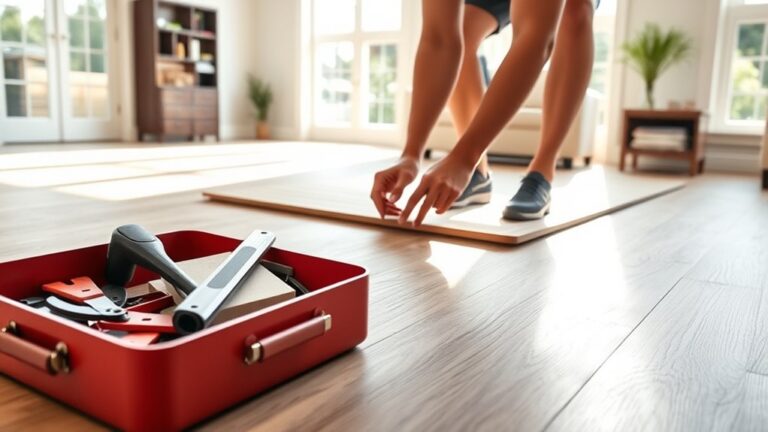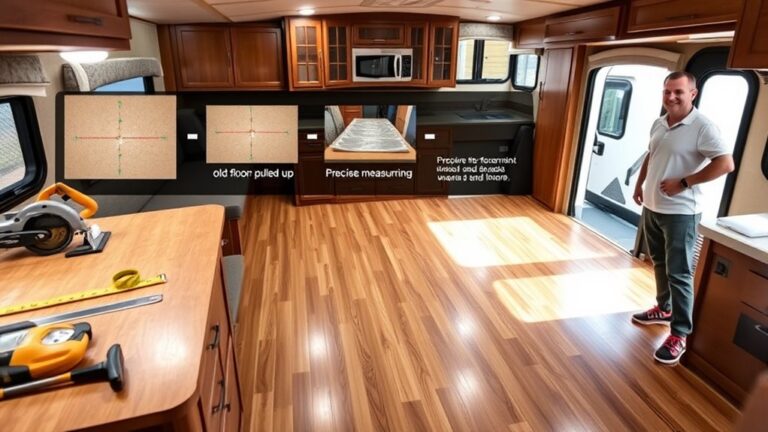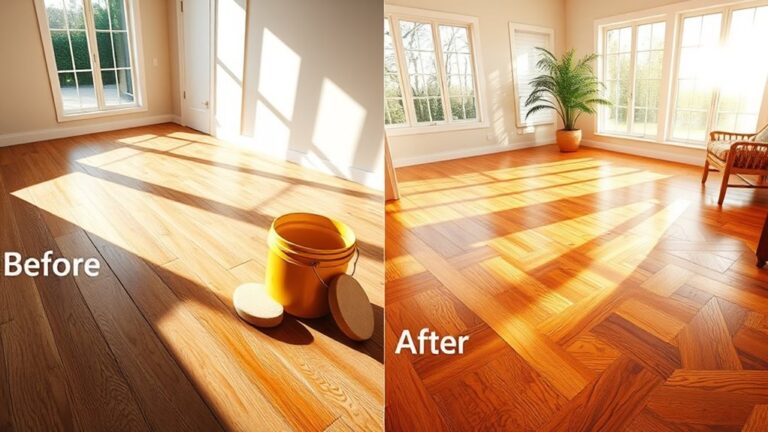To match hardwood floors perfectly, start by identifying the exact wood species and comparing grain patterns to maintain visual flow. Match the wood tone under natural light, considering how it changes over time. Choose a finish type that complements your existing floor’s gloss and texture. Check plank sizes to align grain rhythm, and assess texture for a cohesive feel. Test samples in your space to see real-world effects and harmony. With these steps, you’ll craft a seamless, stylish floor that elevates your room’s ambiance—discover how each detail enhances your design.
Identify the Wood Species
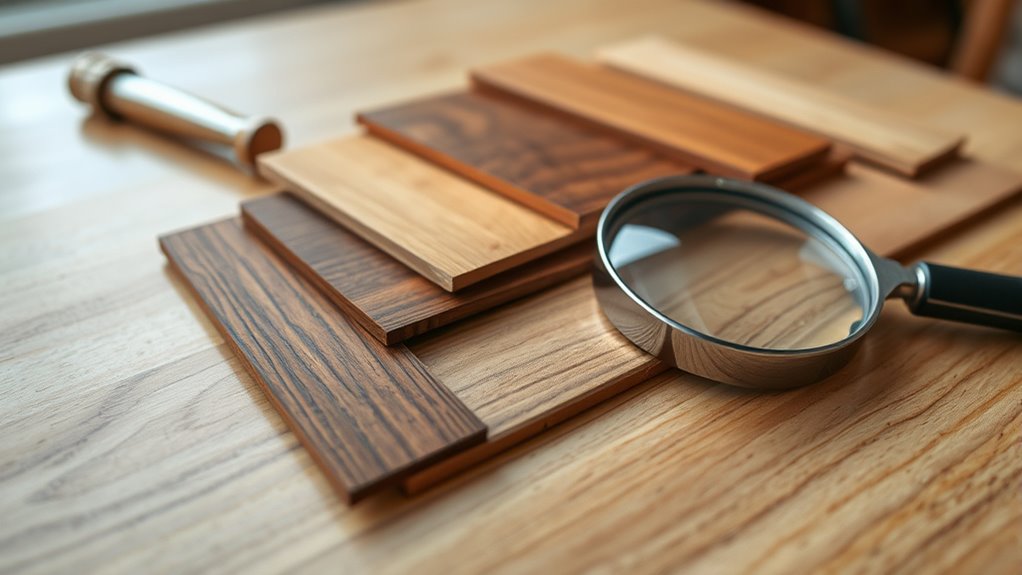
Before you can successfully match hardwood floors, you’ll need to identify the wood species accurately, as each type has its own unique grain patterns, colors, and textures that affect the overall look. Focus on key wood characteristics like color tone, hardness, and pore structure to guide your species identification. Take a close look at the wood’s surface, noting whether it’s smooth or coarse, light or dark, and how it reacts to light. Understanding these elements allows you to choose a match that blends seamlessly, preserving your space’s natural flow and freedom. Accurate species identification guarantees your floor’s harmony remains intact, creating an environment that feels both authentic and effortlessly stylish. This step lays the foundation for a flawless, enduring hardwood floor match.
Compare Grain Patterns
While matching the wood species is essential, you’ll also want to pay close attention to the grain patterns to achieve a truly harmonious look. Grain direction influences how light interacts with the floor, affecting its texture and feel. Ensuring visual consistency means aligning the grain direction across planks, creating a seamless flow that feels natural and free.
| Grain Pattern Type | Grain Direction | Visual Effect |
|---|---|---|
| Straight Grain | Parallel | Clean, linear look |
| Wavy Grain | Undulating | Dynamic, lively feel |
| Cross Grain | Intersecting | Unique, textured style |
Match the Wood Tone
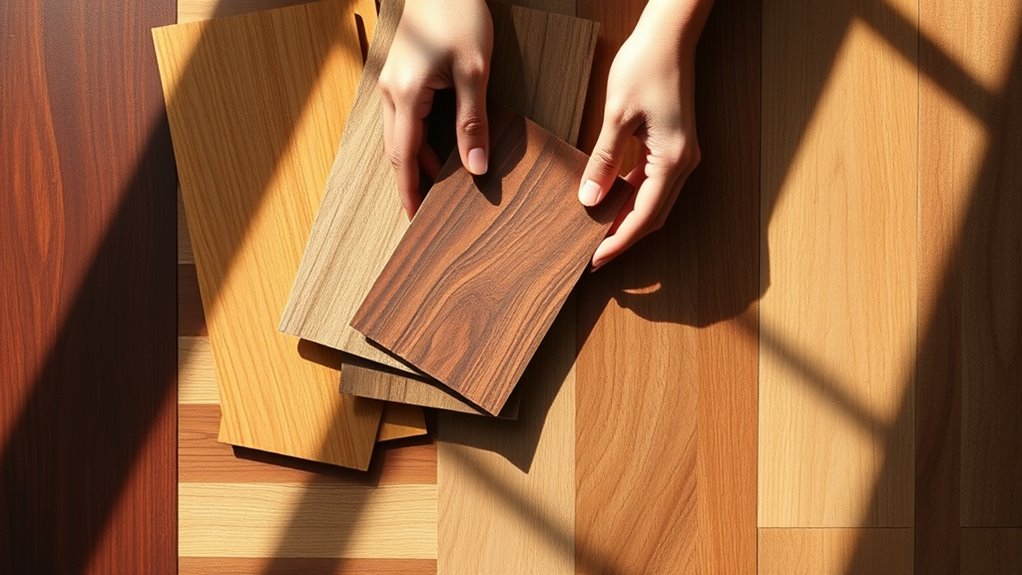
To match your hardwood floor’s tone, start by closely examining the existing color in natural light to capture its true shade. Bring sample wood pieces into the space and compare them side by side, ensuring they blend seamlessly with both color and grain patterns. Paying attention to these details will help you choose wood that complements your current flooring perfectly.
Identify Existing Floor Color
Color is the foundation of a flawless hardwood floor match, and it’s essential you start by carefully examining the existing wood tone. Take note of how color fading has subtly altered the floor over time, especially in areas exposed to sunlight. Don’t rely solely on your first glance—observe under different lighting effects, like natural daylight and warm indoor lights, to see how tones shift. This will help you discern the underlying hues and undertones that define your floor’s true color. Keep in mind, shadows and reflections can deceive you, so take your time. By understanding these nuances, you’ll free yourself from mismatched attempts and confidently select a wood color that flows seamlessly with your current floor, creating an effortless, cohesive look.
Use Sample Wood Pieces
Anyone looking to match hardwood floors should always start by gathering sample wood pieces before making a final decision. Bringing home a variety of sample sizes lets you see how different wood tones interact with your space’s natural light and existing decor. Don’t settle for just one wood variety—explore multiple options to find the perfect match. Lay these samples directly on your floor at different times of day to observe subtle color shifts. This hands-on approach frees you from guesswork and guarantees you select a tone that complements your room effortlessly. By using sample wood pieces, you gain practical insight into how the wood will truly look, helping you achieve a seamless, authentic finish that reflects your personal style and the freedom to create a space you love.
Consider Wood Grain Patterns
While matching the wood tone is essential, paying close attention to the wood grain patterns can make all the difference in achieving a cohesive look. You’ll want to examine the wood grain types—such as straight, wavy, or interlocked—as each brings a unique texture and rhythm to your floor. Matching these patterns helps maintain visual harmony across different boards. Equally important is the wood grain direction, which affects how light reflects and influences the overall flow of your space. Aligning grain direction guarantees a seamless shift between planks, enhancing that natural, unrestricted feel you’re aiming for. By thoughtfully considering both grain types and direction, you create a floor that’s not just matched in color but also rich in depth and character, truly embodying freedom in design.
Consider the Finish Type
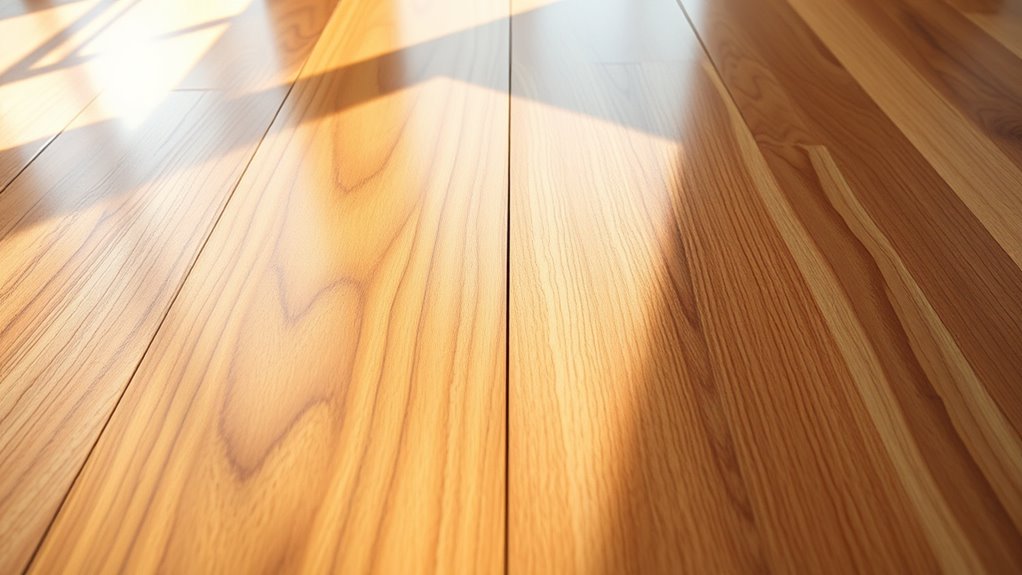
Because the finish type affects both the appearance and durability of your hardwood floors, it’s crucial to choose one that complements your existing flooring. Finish types like matte, satin, semi-gloss, and high-gloss each create distinct visual effects, from subtle elegance to bold shine. When matching, consider how light interacts with the current floor’s finish—does it softly diffuse or sharply reflect? Also, the finish application matters; some floors are factory-finished with a smooth, uniform coat, while others have site-applied finishes with a more textured feel. Pay attention to these details to guarantee your new flooring blends seamlessly, preserving the room’s harmony. Selecting the right finish type isn’t just about looks—it protects your floors and supports your freedom to design without compromise.
Check the Plank Width and Length
You’ll want to carefully measure the width and length of your existing floorboards to guarantee a seamless match. Keep your room size in mind, as wider planks can make a space feel larger, while narrower ones add intricate detail. Don’t forget to align the grain patterns for a natural, cohesive look that enhances the overall beauty of your floor.
Measure Existing Floorboards
Before selecting new hardwood flooring, start by measuring the width and length of your existing floorboards with precision. This step guarantees your new floor blends seamlessly, preserving your room’s natural flow and freedom of style. Use accurate measuring tools like a tape measure or digital laser for reliable results. Follow these floor measurement techniques:
- Measure multiple planks at different spots to account for natural variations.
- Record both width and length, noting any irregularities or wear.
- Double-check your measurements to avoid costly mismatches.
Consider Room Size
Having accurate measurements of your existing floorboards sets a solid foundation, but considering your room’s size will guide your choice of plank width and length to enhance the space’s character. In smaller rooms, narrower planks often work best, making the area feel more spacious and balanced without overwhelming the eye. For larger rooms, wider and longer planks create a sense of openness and continuity, complementing the room functionality by allowing furniture placement and movement without clutter. Keep in mind that the plank dimensions influence space aesthetics considerably—longer planks can draw the eye across the room, while shorter ones add rhythm and texture. By aligning plank size with your room’s proportions and intended use, you’ll achieve a harmonious floor that supports both beauty and freedom in your living space.
Match Grain Patterns
A crucial step in matching hardwood floors is paying close attention to the grain patterns, which can be influenced greatly by the plank width and length. To achieve seamless visual consistency, you need to:
- Examine the grain direction carefully—ensure planks align so the grain flows naturally across the floor.
- Choose planks with similar widths and lengths, as varying sizes disrupt the grain’s rhythm and break the room’s harmony.
- Consider the scale of the grain pattern; wider planks often showcase bolder grains, while narrower ones reveal finer details.
Evaluate the Flooring Texture
When you’re trying to match hardwood floors, paying close attention to the texture is crucial because it influences both the look and feel of the space. Start by identifying the texture types—smooth, hand-scraped, wire-brushed, or distressed—each adds a unique character and tactile experience. Next, consider the surface finishes, such as matte, satin, or glossy, which affect how light plays off the wood and how the floor complements your room’s ambiance. Matching these elements guarantees a cohesive flow, preventing any jarring contrasts that disrupt your space’s harmony. By evaluating both texture types and surface finishes carefully, you gain the freedom to create an environment that feels effortlessly unified and true to your personal style.
Test Samples in Your Space
One of the most effective ways to guarantee your hardwood floor match is spot-on is by testing samples directly in your space. This hands-on approach lets you see how color lighting and room ambiance affect the wood’s appearance throughout the day. Here’s how to make the most of it:
- Place several samples in different areas to observe variations under natural and artificial light.
- Watch how each sample interacts with your room’s colors and furnishings, ensuring harmony with the overall ambiance.
- Live with the samples for a few days to notice subtle shifts in tone and texture as lighting changes.


